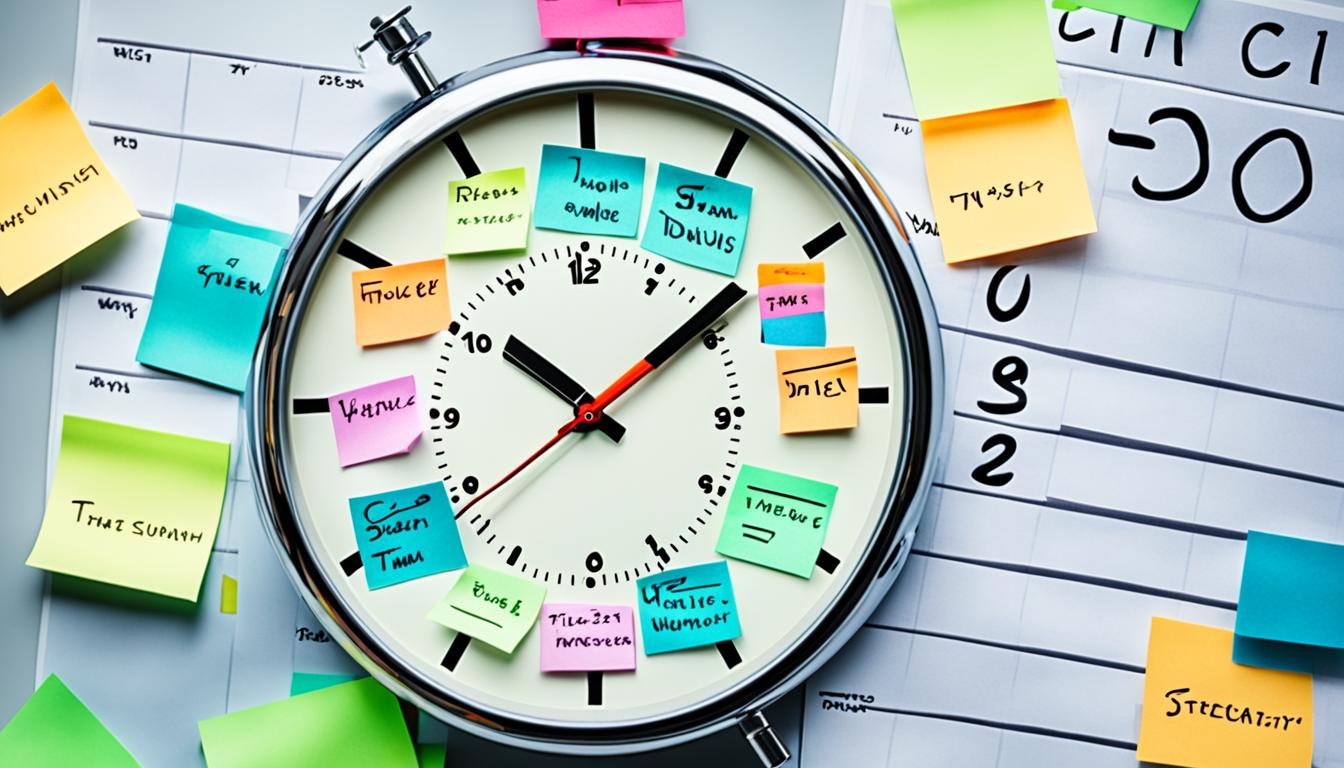Master ADHD Time Management Tools for Success

Do you find yourself constantly running out of time or struggling to stay organized? If you have ADHD, managing time effectively can be a real challenge. But what if we told you there are proven tools and strategies that can help you conquer your time management woes and unlock your full potential?
ADHD affects about 4% to 5% of adults, making it a common condition that interferes with time management and organization. But fear not, because in this article, we’ll explore various techniques and tools designed specifically for individuals with ADHD to help you take control of your time and achieve success.
Key Takeaways:
- ADHD can make time management and organization challenging.
- Externalizing time with analog clocks can improve time perception.
- Creating schedules and to-do lists helps prioritize tasks.
- Breaking tasks into smaller chunks increases focus and productivity.
- Utilizing technology and apps can automate and simplify time management.
Externalizing Time with Analog Clocks
People with ADHD often struggle with estimating time accurately and managing their time effectively. One effective tool that can help with time perception and improve time management skills is the use of analog clocks.
Analog clocks provide a visual representation of the passage of time, making it easier for individuals with ADHD to comprehend how long tasks will take or how much time they have spent on them. By having analog clocks within easy eye-shot, individuals can consciously observe the time, increasing their awareness of time passing.
Imagine this:
When you have analog clocks positioned in your workspace or living areas, you create a constant visual reminder of time passing. This visual representation helps you stay on track with your tasks and avoid underestimating or overestimating the time you have available.
When estimating time, you can take a quick glance at the clock to gauge how much time has passed and adjust your pace accordingly. You become more aware of the need to stay focused and manage your time effectively.
Analog clocks also aid in breaking down tasks into manageable chunks. By dividing your time into smaller increments using the clock’s hour and minute hands, you can allocate specific time periods for different tasks. This allows you to have a clearer view of the time available and the tasks that need to be completed.
Benefits of Using Analog Clocks for Time Management:
- Improved time perception and estimation
- Increased awareness of time passing
- Better task planning and allocation
- Enhanced focus and productivity
Tips for Utilizing Analog Clocks:
- Place analog clocks in prominent locations such as your desk, kitchen, or living room.
- Ensure the clocks are easily visible and accessible.
- Use a variety of analog clocks to cover different areas of your daily routine.
- Regularly check the clocks to keep track of time and adjust your schedule accordingly.
By externalizing time with analog clocks, individuals with ADHD can develop a better sense of time perception and improve their overall time management skills. Being mindful of time passing and utilizing analog clocks strategically can help you stay focused, meet deadlines, and accomplish your tasks more efficiently.
| Analog Clocks | Advantages |
|---|---|
| Visual representation of time | Enhanced time perception |
| Constant reminder of time passing | Improved task management |
| Facilitates breaking tasks into chunks | Increased productivity |
Creating Schedules and To-Do Lists
When it comes to managing time with ADHD, creating schedules and to-do lists is a highly effective strategy. Whether you prefer a traditional paper schedule or a digital one, having a visual representation of your tasks can help you prioritize, set reminders, and allocate time for each activity. By regularly consulting your schedule, you can stay on track and ensure that important tasks are not overlooked.
To make your schedules and to-do lists even more effective, consider the following tips:
- Break down tasks: Instead of overwhelming yourself with large, intimidating tasks, break them down into smaller, more manageable chunks. This approach provides a clear view of the time available and the specific tasks that need to be completed.
- Set reminders and alarms: Reminders and alarms can be a lifesaver for individuals with ADHD. Use them to alert you of upcoming deadlines or when it’s time to switch tasks. This can help you stay focused, maintain momentum, and prevent tasks from slipping through the cracks.
- Prioritize important tasks: Highlight or mark important tasks on your schedule to ensure they receive proper attention. By identifying your top priorities, you can stay organized and prevent unnecessary stress.
Sample Schedule:
| Time | Task |
|---|---|
| 9:00 AM – 10:00 AM | Reply to emails |
| 10:00 AM – 11:30 AM | Work on project A |
| 11:30 AM – 12:00 PM | Take a short break |
| 12:00 PM – 1:00 PM | Lunch break |
| 1:00 PM – 2:30 PM | Work on project B |
| 2:30 PM – 3:00 PM | Review meeting notes |
Remember, your schedule is a flexible tool that helps you stay organized and manage your time effectively. It’s essential to tailor it to your needs and update it as necessary.

Breaking Tasks into Chunks
When it comes to managing your time effectively with ADHD, breaking tasks into smaller chunks is a game-changer. By focusing on one goal or task at a time and completing it before moving on to the next, you can preserve your attention and sense of accomplishment.
Imagine you’re writing a blog post. Instead of overwhelming yourself with the entire writing process, you can break it down into manageable chunks. Start by researching your topic and gathering relevant information. Once that’s done, move on to writing the body paragraphs. By taking it step by step, you build a sense of momentum and increase productivity.
This method not only helps you stay organized but also enhances your ability to complete tasks. By dividing larger tasks into smaller, more manageable sections, you can focus your attention and energy more effectively. Each completed chunk brings you one step closer to accomplishing the overall task.
By breaking tasks into chunks, you’ll find that you feel less overwhelmed and more motivated to work towards your goals. Remember, it’s all about taking one step at a time and celebrating each small victory along the way.

Benefits of Breaking Tasks into Chunks:
- Reduces feelings of overwhelm
- Increases focus and attention
- Boosts productivity and motivation
- Provides a clear roadmap for task completion
- Allows for a sense of accomplishment with each completed chunk
Using Technology and Apps
Technology and apps offer a wealth of resources to assist individuals with ADHD in managing their time effectively. By leveraging these tools, you can enhance your productivity and stay organized. From specialized apps to smartphone features, the possibilities are endless.
ADHD Planner Tools
ADHD planner tools are designed to help you create lists, set reminders, and stay organized. Here are some popular options:
- Evernote: A versatile app that allows you to take notes, create to-do lists, and set reminders. It syncs across devices, ensuring you have access to your information wherever you go.
- Asana: A powerful project management tool that enables you to break down tasks, assign deadlines, and collaborate with others. Its user-friendly interface makes it easy to stay on top of your projects.
- Todoist: A simple yet effective app for managing your tasks and to-do lists. It features intuitive functions like due dates, prioritization, and reminders to keep you focused and motivated.
ADHD Time Tracking Tools
Tracking your time can be instrumental in managing ADHD symptoms and optimizing your productivity. Consider utilizing the following tools:
- Calendars: Take advantage of the built-in calendar app on your smartphone or computer. Use it to schedule tasks, set alarms, and stay organized.
- Reminders: Set reminders on your smartphone for important deadlines, appointments, and events. Let technology do the work of remembering, so you can focus on accomplishing your tasks.
- Timers: Use timers to allocate specific time periods for tasks and activities. This can help you stay on track and prevent distractions from derailing your focus.
Automated Scheduling with Digital Calendar Apps
One of the unique advantages of technology is its ability to automate tasks, making your life easier. By utilizing digital calendar apps, you can streamline your scheduling process and eliminate the need for back-and-forth communication. These apps allow you to invite others to events, share availability, and receive instant updates.
Remember, when choosing which technology or app to use, consider your specific needs and preferences. Experiment with different options until you find the tools that work best for you. With the right technology by your side, managing your time with ADHD becomes more manageable and efficient.
| ADHD Planner Tools | Features |
|---|---|
| Evernote | Note-taking, to-do lists, reminders, synchronization |
| Asana | Project management, task breakdown, deadline setting, collaboration |
| Todoist | Task management, prioritization, due dates, reminders |

Analyzing Patterns and Organizing
When managing time with ADHD, it’s essential to analyze patterns of productivity and inefficiency. By identifying similarities in your peak performance, such as specific times of day or task types, you can schedule your day in a way that aligns with your most productive periods.
Furthermore, organizing items and creating designated spots for important belongings can prevent misplacement and save you time searching for things. When everything has a home, you eliminate the frustration of searching for misplaced items, allowing you to focus on the task at hand.
Optimizing Productivity with Schedule Analysis
Analyzing your productivity patterns involves observing your energy levels and task performance throughout the day. Notice when you feel most alert and engaged and during which tasks you excel.
For example, if you find that you are most alert and focused in the morning, schedule your most challenging tasks during this time. By matching your energy levels and strengths with the appropriate tasks, you can maximize your productivity and achieve better results.
The Power of Organization and Item Placement
Creating an organized environment is key to managing time effectively. When your workspace is clutter-free and items are easily accessible, you save precious time and avoid distractions.
Consider using tools such as bins, shelves, and label makers to create a system for organizing your belongings. Mentally mapping out where each item belongs can also help prevent misplacement and ensure a smoother workflow.
By implementing these strategies—analyzing productivity patterns and optimizing organization and item placement—you can enhance your time management skills and improve your overall productivity.
| Benefits of Analyzing Patterns and Organizing | Actions to Take |
|---|---|
| 1. Maximize productivity by scheduling tasks during your peak performance periods. | 1. Reflect on your energy levels and task performance throughout the day. |
| 2. Eliminate time wasted searching for misplaced items. | 2. Create designated spots for important belongings. |
| 3. Reduce distractions and maintain focus. | 3. Use organizational tools such as bins, shelves, and label makers. |

Conclusion
Managing time with ADHD can be challenging, but with the right strategies and tools, you can overcome these obstacles and improve your time management skills. By implementing effective ADHD time management tools and strategies, you can boost your productivity and unlock your full potential.
One key technique is externalizing time by using analog clocks. By making time more visible and tangible, you can better understand how long tasks will take and increase your awareness of the passage of time. Creating schedules and to-do lists is another powerful strategy. By prioritizing tasks, setting reminders, and allocating time for each activity, you can stay organized and focused.
Breaking tasks into smaller chunks is also vital. By focusing on one task at a time, you can maintain your attention and experience a sense of accomplishment as you complete each part. Technology and apps can be valuable aids as well, offering tools like reminders, lists, and calendars to help you stay on track.
Lastly, analyzing patterns of productivity and organizing your belongings can further improve your time management. By identifying the times and tasks when you are most productive, you can schedule your day accordingly. Additionally, having designated spots for important items can save you time and frustration searching for them.
Remember, with the right tools and strategies, you can conquer your time management challenges and unlock your full potential. By implementing these ADHD time management techniques, you are one step closer to achieving your goals and enjoying greater success in all areas of your life.
FAQ
What are some effective tools for managing time with ADHD?
Some effective tools for managing time with ADHD include externalizing time with analog clocks, creating schedules and to-do lists, breaking tasks into smaller chunks, using technology and apps, and analyzing patterns of productivity.
How can externalizing time with analog clocks help with time management for individuals with ADHD?
Externalizing time with analog clocks can make the passage of time more visible and help individuals with ADHD better understand how long tasks will take or how much time they have spent on them.
How can creating schedules and to-do lists help individuals with ADHD manage their time effectively?
Creating schedules and to-do lists can help individuals with ADHD prioritize tasks, set reminders and alarms, and allocate time for each task. It provides a clear view of the time available and the tasks that need to be completed.
What is the benefit of breaking tasks into smaller chunks for individuals with ADHD?
Breaking tasks into smaller chunks helps individuals with ADHD focus on one goal or task at a time, preserve their attention, and provide a sense of accomplishment. It increases productivity and prevents feeling overwhelmed.
How can technology and apps assist individuals with ADHD in managing their time?
Technology and apps such as Evernote, Asana, and Todoist can help individuals with ADHD create lists, set reminders, and stay organized. Smartphone features like calendars, reminders, and timers can also be used to track tasks and set alarms.
How can analyzing patterns of productivity and organizing belongings help individuals with ADHD manage their time?
Analyzing patterns of productivity helps individuals with ADHD identify their most productive periods and schedule tasks accordingly. Organizing belongings and creating designated spots for important items prevents misplacement and saves time searching for things.
How can individuals with ADHD improve their time management skills and productivity?
By implementing effective time management tools and techniques, such as externalizing time, creating schedules and to-do lists, breaking tasks into smaller chunks, using technology and apps, analyzing patterns, and organizing belongings, individuals with ADHD can improve their time management skills and increase their productivity.





